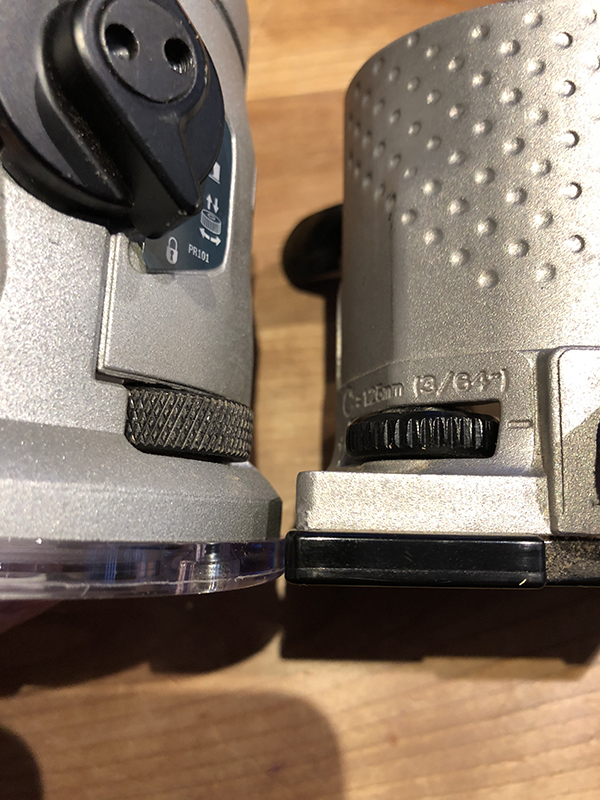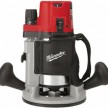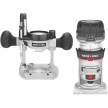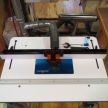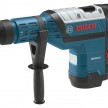Comparing the Bosch Colt Router GKF125CE to the Older PR20EVS
Bosch Colt Router Comparison GCK125CE vs. the PR20EVS – “A Look-Back”
Trim Routers play a key role in my workshop. I have a Bosch Colt Router PR20EVS along with two others and I use them for round-overs, final pattern clean up and chamfers. I have each trim router setup with specific bits to do repeat tasks. In that way, a chamfer that I cut 6 months ago will mate up with a chamfer that I cut today. The new Bosch COlt GCK125CE is impressive enough to become my go-to trim router.
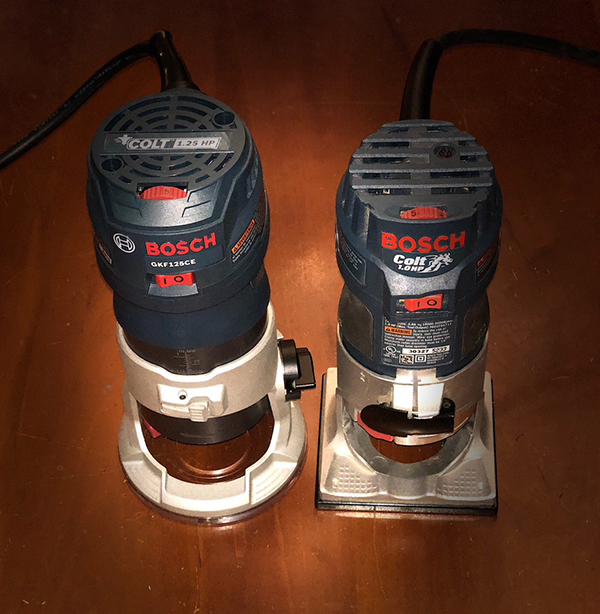
One of the staples in my shop is the Bosch Colt Router PR20EVS that I bought about 5 years ago. This 1 hp. palm router has made hundreds of cuts for me. I have set this tool up for cutting chamfers with a piloted 45 deg. chamfer bit.
Bosch Colt Model GKF125CE Router – Next Gen
When I had an opportunity to test the new Bosch Colt Model GKF125CE palm router, I expected that I would be looking at a slightly repackaged tool that I already knew very well. Boy did I have wrong expectations!
A closer look at the two routers yields a number changes that are notable. I will highlight each of the important changes, below:
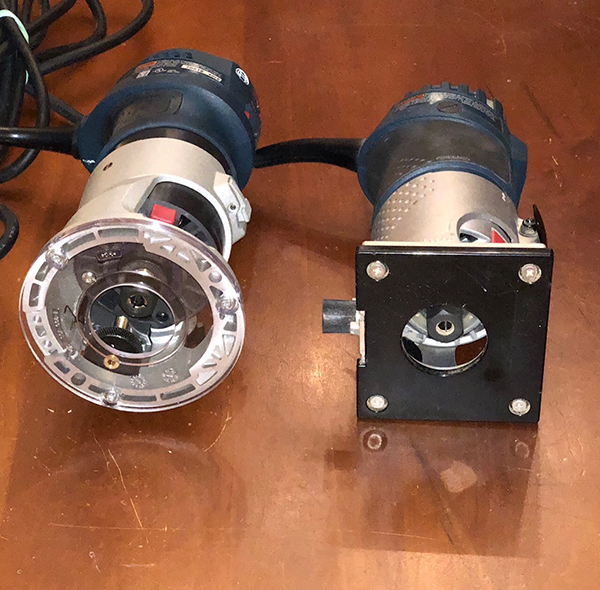
ROUTER BASE SHAPE:
Right out of the box, the one change that the Bosch designers made is obvious. The older model has a black rectangular base and the Bosch GKF125CE has an acrylic round 4 1/8 inch base. While the rectangular base is offset in relation to the centerline of the spindle, the clear circular base is concentric and the see through benefits are obvious. Not only are the safety aspects better, but also the concentric base means hassle-free guidance along templates or straight edges.
POWER:
The new generation does not have external brush covers and leads me to believe the GKF125CE may have a brushless motor. (I could not verify that with information from the Bosch Web site.) In any case, the horsepower rating for the new unit is 25% greater at 1.25 hp. The motor has a variable speed control that lets the user dial in speeds from 16,000 to 35,000 rpm. In addition, the motor circuitry monitors and maintains the shaft speed as the load on the bit changes.
LED LIGHT:
The base of the router contains two LED lights that do a great job of illuminating the work area. Coupled with the transparent polycarbonate base, the work area is very visible. The prior model had no lighting and an opaque base.
CORD STRESS RELIEF:
Even the GFK125CE’s cord is improved. The older model had a well-designed and beefy cord stress relief. But the stress relief on the GKF125CE shows a great attention to detail. The new cord design has a ball joint swivel for better stress relief and easier cord positioning. Under use in the shop, I appreciated the ability to move the cord to one side or the other to get it out of the way. Since the cord is not rigidly attached to the housing, it does not spring back to the middle of the router body. This is a small, subtle feature, but it makes a big difference under use.
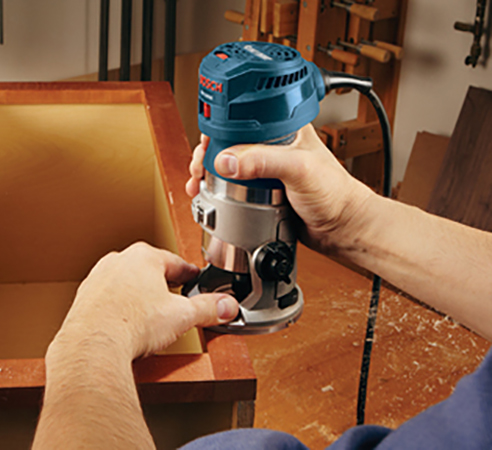
FINGER SUPPORT POCKETS:
I do not use the embedded finger pockets very often on the PR20EVS. When I have used them, I was not comfortable doing so, because there was not a tall, positive tactile end between my fingers and the area of the operating router bit. The GKF125CE changed that condition. The redesigned finger support pockets have a well-defined finger pocket with a high ridge separating the fingers from the router bit. I was very comfortable using this feature on the GFK125CE.
HEIGHT ADJUSTMENT KNOB:
Talk about attention to usability details! The height adjustment knob on the GKF125CE hits the mark on improvements. While the adjustment for both Colt routers is similar in concept, the GFK125CE has a much better implementation. While I did not think the action on the height adjustment on the PR20EVS was lacking, its faults become glaring in direct comparison to the height adjustment on the GFK125CE. Not only is the new design much larger in terms of contact area, the materials are metal in lieu of plastic and the knurling on the thumb wheel has substantially more bite on the thumb than the older model. The picture, below, shows these differences:
Height Adjustment Mechanism:
Perhaps the most dramatic change between models is the way that the height adjustment works. With the PV20EVS, the user first unlocked the clasp on the front of the router to release the barrel from the base. Next, the user rotated the barrel of the router in the base to unlock the screw adjustment mechanism. That action enables large height adjustments. When the height is close to the desired height, the user rotated the barrel back to the locked position and used the screw for fine adjustments. When the height was correct, the user closes the clasp on the opposite side of the barrel to complete the adjustment.
However, with the GFK125CE, the user makes all of the height adjustments in one place on the router. A large winged black knob makes all of the adjustment steps. The first turn of the knob releases the locking of the barrel from the base in one click. If a large adjustment in desired, the user clicks the black knob to the top. The barrel is now free to slide to a new location relative to the base. For finer adjustments, the user turns the knob to the middle position. That engages the screw adjustment. When the router is at the final position, a final click to the bottom position locks the adjustment into place. A close up of the redesigned adjustment mechanism is shown, below:
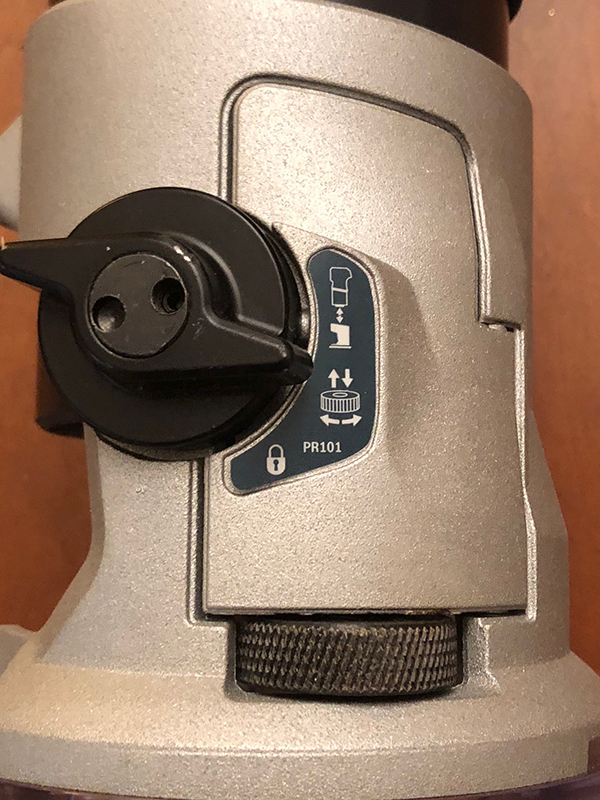
Which Generation Router is Better?
In summary, the GFK125CE has made a great product even better. This router is such an advancement in ease of use, safety and power that I will make this my go-to trim router. I was very pleased to see the changes and Bosch has a real winner in its new GFK125CE trim router.
Bosch GFK125CE Features
- Powerful 1.25 hp (max) 7.0 amp motor for compact versatility
- LED lighting provides enhanced view of bit area
- Durable spindle lock for fast, easy bit changes
- Ball-joint cord swivel for easiest cord positioning
- Finger support pockets for additional stability, especially when trimming edges
- Easy motor removal with press of release button
- Depth scales in both inches and metric for user versatility and convenience
- Palm-grip design with soft grip, making it the most comfortable router in its class
- Innovative depth-adjustment system for easy and precise depth adjustment
- Variable speed dial from 16,000 to 35,000 rpm for matching speed to workpiece and task
- Rugged 360° aluminum base housing ensures excellent perpendicularity
- Soft-start circuitry reduces start-up torque
- Constant Response™ circuitry monitors and maintains speed under load for consistent performance
- Wide-bit capacity — PR101 fixed base accepts bits up to 1-5/16-in. wide
- Round translucent polycarbonate subbase with can be centered for worry-free guidance along templates




